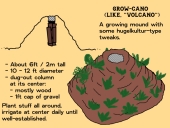




Hugo Morvan wrote:I did a tour this winter (feb/march) in Spain and people were very happy with all the rain. I am wondering if it's still as bad as last year by now. Did it have a lasting effect? Maybe not so for plants that root close to the surface, but are the trees with deep roots profitting?
Insect hotels attract a lot of insects, but also concentrate the egglaying in one place, it's easy for predators of the mason bees for instance then to lay eggs. When nature was wilder,with lots of stalks and plant debris left in place it was a better environment for insects. Here in France an organisation emerged contracting farmers not to cut the trees they plant in their hedges, 90 different species they offer, miles of insects refuges bringing down insect pressure on crops because they harbor predator insects as well...


Jennie Little wrote:I had, my estimation, 100,000 books. No that is NOT a typo. I was a used/antiquarian book dealer. I know how to sell valuable books. I know how to sell collectible books, etc. That is a LOT of what slows the process down, namely researching things. It doesn't take a long time, but actually looking up every book, even if it's < 2 minutes, is a lot.
I'm not keeping books my appraisal comes back as worth $10 or less. One bookstore that's selling my stuff does comics, illustrated books, and pulps, mostly on Ebay. The other is a high-end antiquarian book dealer. The fellow I"m giving books to is a used/antiquarian dealer as well.
I've been scouting books (finding them), buying and selling them professionally and not since around 1978, when I started working in my first book store.
My last store was at the end of an alley. And the low point of the street, ajacent parking lot and the alley. No drainage. I ended up standing in ankle deep water one day and I didn't dare open the door, there was more outside!
What I wanted from this thread? Hm acknowledgement of how hard it was I suppose. Getting rid of the addictive thing is hard, even if you're not using any more... A place I could be a bit whiney I guess too? I have been giving and selling books, fabric, beads, craft supplies, food stuffs, garden equipment, clothing, and kitchen stuff away for years and still have too much. A long time ago I realized I had 2 major hurdles: too much stuff and bad habits.
The habits aren't just "fix it" things, because being consistent and repetitve with it pushes on the PTSD, and I have panic attacks.
People who've known me a long time say there's noticeably fewer books here. I'm sure there is. I used to have a "goat trail" thru the stacked 8 high tomato boxes, full of books instead of the living room. That's not true now.
We have 1 storage unit, but the books aren't stored there, unless they're going to the bookstore the next time we go. There's probably say 20 or less books there, if there's any at all. The storage is because we were having the house painted/new windows last summer and we expected to get our downstairs wood floor sanded/varnished, etc. House painting/upstairs windows were finally finished in November, but we'd moved furniture, flea market merch (long gone), etc. to make room so people could get at the walls upstairs.
Other people see the difference. I know there is one. But all I really see is how much is still here... and the fact that the books i want to keep are still far too many to fit into the bookshelves, although I keep culling.


